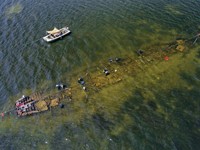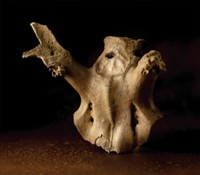Advertisement
Grab your lab coat. Let's get started
Welcome!
Welcome!
Create an account below to get 6 C&EN articles per month, receive newsletters and more - all free.
It seems this is your first time logging in online. Please enter the following information to continue.
As an ACS member you automatically get access to this site. All we need is few more details to create your reading experience.
Not you? Sign in with a different account.
Not you? Sign in with a different account.
ERROR 1
ERROR 1
ERROR 2
ERROR 2
ERROR 2
ERROR 2
ERROR 2
Password and Confirm password must match.
If you have an ACS member number, please enter it here so we can link this account to your membership. (optional)
ERROR 2
ACS values your privacy. By submitting your information, you are gaining access to C&EN and subscribing to our weekly newsletter. We use the information you provide to make your reading experience better, and we will never sell your data to third party members.
Geochemistry
Newscripts
Rock mysteries, terrestrial and martian
by Shi En Kim
November 3, 2022
| A version of this story appeared in
Volume 100, Issue 39
Desert varnish’s secrets

The micrometers-thick mineral coating known as desert varnish that paints stony surfaces black or rust is as ubiquitous as it is odd. It can be found in arid landscapes across the world—staining boulders burnt orange in Chile’s Atacama Desert or as part of the petroglyphs etched in southeastern Utah’s canyon walls—and possibly beyond.
Scientists have studied desert varnish for over a century, but they still don’t fully understand how it forms. The components of the varnish, alternating bands of manganese oxide and iron oxide embedded in silica, come from dust. But these oxides’ high concentration flummoxes scientists.
Some theories suggest that the oxides interact with silica, which also cements everything to rocks. Another popular explanation is that desert varnish is a mark of microbes at work. They may consume manganese oxide as an oxidant and leave behind an enriched ferric layer, only to redeposit the reduced manganese ions on the surface.
The wide variety of desert varnish makes it easy for scientists to find counterexamples to every origin theory proposed. Abiotic theories don’t explain why it grows much more slowly, at micrometers per millennia, in the driest deserts than regions that receive more rainfall. The microbial premise doesn’t account for varnish formation in low-sunlight areas or other extreme environments that are unfavorable to microbial life.
Because desert varnish often traps organic matter, scientists can use the varnish to learn about ancient life entombed in the dark layers. Last year, the Perseverance rover spied purple smears on rocks nearly everywhere it looked as it traversed the ruddy martian landscape. Varnish, scientists suspect. They’re now scrutinizing these bruise-colored stains for evidence of ancient life on the Red Planet.
The enigma of desert varnish has invited a stranger suggestion: perhaps desert varnish is made by life, but not life as we know it. These hypothetical organisms may have or have had a different biochemistry than ours, so they’d be unrecognizable by current detection methods. Carol Cleland, a professor of philosophy at the University of Colorado Boulder, calls this invisible ecosystem “the shadow biosphere.”
“It’s possible that there are microbial forms of life descended from an alternative origin of life,” she says. When life first emerged on Earth, “there must have been a lot of natural experimentation going on.”
The shadow-biosphere hypothesis is less than rock solid, though. “Until you come up with a way of disproving an idea, you cannot ‘do science’ on the issue,” Ronald Dorn, a professor of geography at Arizona State University, says via email.
There’s something scientists can agree on: desert varnish is bewitching. This ancient accretion intrigued naturalists such as Alexander von Humboldt and Charles Darwin, yet scientists’ understanding is still only scratching the surface.
Vomitoxin hints at hidden figure

When University of Glasgow geochemist Áine O’Brien was studying the chemicals on a martian meteorite sample in 2019, the last thing she expected was to fall into a mystery of plant pathology and history. The space rock in question is Lafayette, named after the Indiana metropolitan area surrounding Purdue University, where the stone was first identified as a meteorite. A 1935 account claimed that a Black student at Purdue saw the meteorite plunk into a pond, recovered it, and donated it to the university. But the donor’s identity was unknown.
O’Brien’s meteorite sample contained vomitoxin, also known as deoxynivalenol, a fungal toxin that causes sickness in humans and livestock. She reported her finding to her supervisor, who mentioned that the fungus wreaks havoc on crops in Indiana.
Looking through historical records for the fungus’s prevalence in the area, O’Brien’s team noted two drops in crop yield near the time of the meteorite discovery: in 1919 and 1927. The years also matched up with reports of fireball sightings. At these times, the fungal disease could have been so widespread that the vomitoxin could have found its way into waterways—such as a pond—and contaminated any object—say, a meteorite—that fell in.
The team scoured yearbooks to find Black students who were enrolled during those years. Four names stood out: Julius Lee Morgan, Clinton Edward Shaw, Hermanze Edwin Fauntleroy, and Clyde Silance. The first three were students in 1919; Silance in 1927.
Beyond that, the world may never know who exactly the meteorite’s discoverer was. But O’Brien says this is an important story to tell, “of someone who was never given the credit for what was an amazing piece of Mars.”
Please send comments and suggestions to newscripts@acs.org.





Join the conversation
Contact the reporter
Submit a Letter to the Editor for publication
Engage with us on Twitter